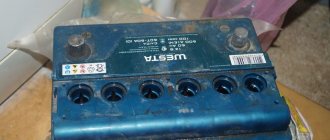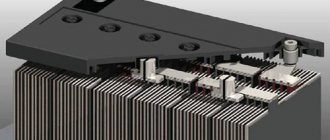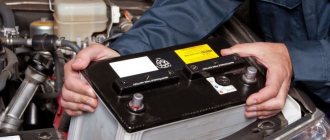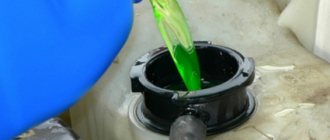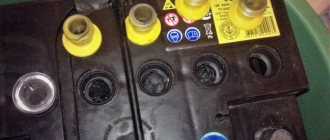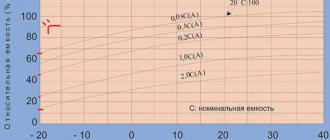Lead-acid batteries have been around for more than a century and a half, but they have not lost their position in the automotive industry to this day. There are two main reasons for this: low cost and frost resistance. A lithium-ion battery, although it is much more compact and lighter with a capacity comparable to a lead-acid one, is several times more expensive and already at 0° C its capacity will drop by half (while for a lead battery this will only happen at -30° WITH). And this is not to mention the much greater demands on charge and discharge conditions.
Maintenance-free calcium and AGM batteries are becoming increasingly popular, but traditionally serviceable batteries can still be seen under the hood of a car. Monitoring the level and condition of the electrolyte increases the battery life, and most importantly, protects against problems in winter, which is only a plus for the “handy” owner.
Battery operating principle
When talking about the density of battery electrolyte, we need to start with the very principle of operation of car batteries. During charge-discharge, about 60 reactions occur in the battery, according to research dating back to Soviet times, but the main one is only one: during the discharge process, lead oxide on the cathode (negative electrode) and lead on the anode (positive electrode) “take away” sulfate -ions from a solution of sulfuric acid, turning into lead sulfate, and water is additionally formed at the cathode, and when charged, lead sulfate, on the contrary, “gives” sulfate ions to the electrolyte.
Thus, during a discharge, the density of the electrolyte drops; with a complete discharge, distilled water actually remains between the plates, and during charging it increases. Then why does the density of the solution in the battery decrease over time if these processes are mirror-image?
The reason is that the lead sulfate formed when the battery is discharged is not always completely consumed during charging. This is especially noticeable in the cold and after the battery has been in a discharged state for a long time: the plates are first covered with white stains of coarse-crystalline lead sulfate, and then these crystals gradually fall down and practically do not participate in the further reaction that takes place during charging.
Therefore, sulfation of battery plates is clearly a harmful phenomenon. The capacity of the battery and the strength of the plates decrease, and due to a drop in the density of the electrolyte, the battery is less able to charge: the lower the density of the solution, the worse the conductivity. A completely discharged battery practically does not accept a charge - the electrolyte resistance between its plates is too high.
However, the density may increase over time. Since the electrolyte is not pure sulfuric acid, but its aqueous solution, when charging the battery, another reaction occurs: banal electrolysis of water, unnoticeable at the beginning of the cycle, but increasing towards the end. Therefore, old recommendations for charging serviced batteries advised waiting for the battery to “boil” - a sharp increase in the release of oxygen and hydrogen in the banks. Losing water, over time the electrolyte will lower its level, and its density will inevitably increase - even taking into account the gradual binding of sulfuric acid on the plates and in the scree, water is lost faster during “boiling”.
Why does the density of battery electrolyte decrease?
Details Category: Car sales blog Created: January 23, 2019
Reasons for the drop in electrolyte density
In a car battery, the main composition consists of a case with canisters of electrolyte inserted inside, a sensor that monitors the density of the solution and terminals. This is all connected to the output of the car's electrical circuit.
If the charge level is too low, the car will not start. If the battery is well charged, the problem is the reduced density of the electrolyte and poor performance of the battery, which does not produce the necessary parameters. It will be possible to detect the problem using the necessary probe in a working battery or using an indicator that must be mounted in the can.
For what reasons does the electrolyte density decrease?
For good battery performance, it is necessary to prevent discharge below 50% and maintain high temperatures maintained by chemical processes in the electrodes and electrolytes.
Normal electrolyte density
Pure sulfuric acid is not used in batteries - it is extremely dangerous, and the rate of plate sulfation increases significantly even during normal operation. For operational reasons, the density of the battery electrolyte was chosen to ensure reliable operation at low temperatures, sufficient specific capacity and charging speed.
Under normal conditions (which in physics usually means, among other things, a temperature of +20° C), the density of the electrolyte in a fully charged battery is 1.28-1.3 g/cm3. As you can see in the illustration above, it is this density that provides the greatest frost resistance. At the same time, it is noticeable that a completely discharged battery has a very high risk of freezing in winter - it is enough for the temperature to drop below -5 for ice crystals to form in the electrolyte.
Winter and summer electrolyte density
However, in practice, measuring the density of the electrolyte in a battery at a strictly specified temperature is impossible: in winter in a garage, the density of a working and charged battery will increase, and in summer, and even immediately after a trip, on the contrary, it will be lower. Therefore, a system of corrections for measurements has been adopted depending on the battery temperature, which is shown in the table below:
| Electrolyte temperature, °C | Amendment, g/cm3 |
| From –40 to –26 | –0,04 |
| From –25 to –11 | –0,03 |
| –10 to +4 | –0,02 |
| From +5 to +19 | –0,01 |
| +20 to +30 | 0,00 |
| From +31 to +45 | 0,01 |
Thus, if you measure the density in winter during light frost (up to -10), then for a charged battery it should be 1.3-1.32 g/cm3, since with an adjustment of -0.02 we will get “standard” 1.28-1.3. In the heat, the normal density will be 1.27-1.29 g/cm3.
Something else useful for you:
- Car battery maintenance and diagnostics
- Gel battery - pros and cons
- Oxidation of battery terminals: what are the reasons and how to avoid
Electrolyte density in the battery
Most of the batteries sold in Russia are semi-serviceable. This means that the owner can unscrew the plugs, check the level and density of the electrolyte and, if necessary, add distilled water inside. All acid batteries, when they first go on sale, are usually 80 percent charged. When purchasing, make sure that the seller performs a pre-sale check, one of the points of which is checking the density of the electrolyte in each of the cans.
In today's article on our portal Vodi.su we will look at the concept of electrolyte density: what it is, what it should be in winter and summer, how to increase it.
In acid batteries, a solution of H2SO4, that is, sulfuric acid, is used as an electrolyte. Density is directly related to the percentage of the solution - the more sulfur, the higher it is. Another important factor is the temperature of the electrolyte itself and the surrounding air. In winter the density should be higher than in summer. If it drops to a critical level, the electrolyte will simply freeze with all the ensuing consequences.
This indicator is measured in grams per cubic centimeter - g/cm3. It is measured using a simple hydrometer device, which is a glass flask with a bulb at the end and a float with a scale in the middle. When purchasing a new battery, the seller is required to measure the density; it should be, depending on the geographic and climatic zone, 1.20-1.28 g/cm3. The difference between banks is allowed to be no more than 0.01 g/cm3. If the difference is greater, this indicates a possible short circuit in one of the cells. If the density is equally low in all banks, this indicates both a complete discharge of the battery and sulfation of the plates.
In addition to measuring density, the seller should also check how the battery holds the load. For this, a load fork is used. Ideally, the voltage should drop from 12 to nine volts and stay at this level for some time. If it drops faster, and the electrolyte in one of the cans boils and emits steam, then you should refuse to purchase this battery.
Density in winter and summer
This parameter for your specific battery model should be studied in more detail in the warranty card. Special tables have been created for the different temperatures at which the electrolyte can freeze. Thus, with a density of 1.09 g/cm3, freezing occurs at -7°C. For northern conditions, the density should exceed 1.28-1.29 g/cm3, because with this indicator its freezing temperature is -66°C.
Density is usually indicated for an air temperature of +25°C. For a fully charged battery it should be:
- 1.29 g/cm3 - for temperatures ranging from -30 to -50°C;
- 1.28 - at -15-30°C;
- 1.27 - at -4-15°C;
- 1.24-1.26 - at higher temperatures.
Thus, if you operate a car in the summer in the geographic latitudes of Moscow or St. Petersburg, the density can be in the range of 1.25-1.27 g/cm3. In winter, when temperatures drop below -20-30°C, the density increases to 1.28 g/cm3.
Please note that there is no need to “increase” it artificially. You simply continue to use your car as usual. But if the battery discharges quickly, it makes sense to carry out diagnostics and, if necessary, charge it. If the car is left in the cold for a long time without work, it is better to remove the battery and take it to a warm place, otherwise it will simply discharge due to prolonged inactivity, and the electrolyte will begin to crystallize.
Practical advice on battery operation
The most basic rule to remember is that you should never put sulfuric acid into the battery. Increasing the density in this way is harmful, since with an increase, chemical processes are activated, namely sulfation and corrosion, and within a year the plates will become completely rusty.
Check the electrolyte level regularly and add distilled water if it drops. Then the battery must either be charged so that the acid is mixed with water, or the battery must be charged from a generator during a long trip.
If you park the car, that is, do not use it for some time, then, even if the average daily temperatures drop below zero, you need to make sure that the battery is fully charged. This minimizes the risk of electrolyte freezing and destruction of the lead plates.
As the density of the electrolyte drops, its resistance increases, which, in fact, makes starting the engine difficult. Therefore, before starting the engine, warm up the electrolyte by turning on the headlights or other electrical equipment for a while. Don't forget to also check the condition of the terminals and clean them. Due to poor contact, the starting current is not enough to produce the required torque.
How to measure battery density
First, you need to install the battery on a flat horizontal plane and clean the cover from dust and dirt. It is better to use a cloth moistened with a weak solution of soda, as the most accessible alkali: it neutralizes possible sweating of the electrolyte around the plugs.
Now we check the electrolyte level. It is easier to do this on batteries with translucent walls - there are marks on the walls, with the help of which you can immediately understand whether the level is within the acceptable range. Not only the height of the level itself is important, but also the uniformity across the jars: where the electrolyte level is noticeably lower, a malfunction is possible (leakage of the walls or bottom, rapid “boil-off” of the electrolyte due to its excessive initial density, and so on). If the walls of the battery are opaque, use a transparent tube, lowering it into the holes of the plugs until it stops in the set of plates and then plugging the upper end with your finger: when you pull out the tube, you will see how much the electrolyte is above the plates. The norm is a level height of 10-15 mm above the plates.
If the electrolyte level in any jar is below normal, bring it to the required level by carefully adding distilled water. As we already wrote above, most often the level decreases due to water loss due to electrolysis, so it is impossible to replenish the level with ready-made electrolyte.
Before checking the density, ensure that the battery is 100% charged - connect the charger until it “boils” or until it turns off if you are using an automatic model. This is also necessary so that the density in the jar is equalized after adding distilled water, otherwise the measurement will give an erroneous result.
A common device for monitoring density is a hydrometer, which is a transparent flask with a bulb for collecting liquid. Inside this flask there is a weight with divisions - it will plunge into the collected electrolyte to a height depending on the density of the battery and the risk at which it is immersed, and will indicate the measurement result.
However, there is a more convenient and versatile device - we are talking about an optical refractometer, which is also capable of measuring the freezing temperature of coolant and washer fluid. To measure, just drop a drop from a pipette onto the desired location and press the drop with a transparent glass lid. By looking at the light through a refractometer, you will see the density of the electrolyte by the mark. This is faster and more accurate than the usual method with a hydrometer.
How to increase the density of electrolyte in a battery yourself?
The density of the battery, or more precisely, the electrolyte in it, can be increased quite simply without contacting service center specialists. First of all, it is necessary to carry out a number of preparatory procedures:
- Prepare containers that will be needed to drain some of the old electrolyte from the battery;
- Get personal protective equipment - gloves, glasses, clothes (which you don’t mind getting ruined). Remember: Battery electrolyte partly consists of sulfuric acid, which is dangerous and, if it comes into contact with the skin, can cause burns and seriously damage clothing;
- Take the tools you will need to increase the density of the electrolyte in the battery: hydrometer, enema bulb, measuring cup, funnel;
- Buy the necessary consumables: distilled water, battery acid or ready-made electrolyte.
Related article: How to properly tighten wheel bolts
To increase the density of the electrolyte in the battery, you will have to completely replace all the electrolyte that is already poured into the battery with a new solution. This is quite easy to do if you follow the instructions and take the necessary precautions.
Checking electrolyte density
An electrolyte is a solution that mostly consists of distilled water containing 35% sulfuric acid. During operation, the density of this substance may change. Often the indicator drops due to the periodic addition of distilled water, which is required to maintain the optimal level.
When the battery is charged, water evaporates, and if the distillate content exceeds the norm, the electrolyte also boils away. In this case, the indicator may drop too low, the battery will stop working normally, and the engine will not start.
Before deciding how to increase the density in a car battery, you need to correctly measure it, taking into account the ambient temperature. It is better to carry out the procedure at +25 degrees.
Preparing for work:
- Gloves and goggles for protection, clothes that you don’t mind - all this is mandatory, since the working fluid contains sulfuric acid (contact with the skin leads to serious burns, even vapors can harm a person, so the room must be well ventilated);
- Densimeter - required to determine the density of the solution, presented in the form of a glass tube with a rubber tip and a bulb, with a hydrometer located inside.
How the check is performed:
- The drive must be removed from the machine.
- If protection is provided, it is dismantled, then the caps of the cans are unscrewed.
- Next, the amount of solution in the system is checked. For passenger models, the composition should be 1.5 cm above the plates.
- A full battery charge is important. The test begins a few hours after charging is completed. If the level is normal, the densimeter is lowered into the jars, collecting a small amount of liquid.
- Depending on the temperature, the performance of the device is evaluated. In this case, the hydrometer should be in a calm state, floating in the solution; touching the walls of the device is not allowed.
- By recording the results obtained after testing each can, you can compare them, determining the optimal density and charge level.
Attention:
This method is suitable for collapsible models, where it is possible to independently control the indicators and replace the solution. If the battery is maintenance-free, a special indicator is provided for monitoring, which, depending on the color, indicates a certain level of density and the need to increase.
What is density
As you know, the electrolyte plays an important role in the operation of the battery. It is a mixture of sulfuric acid (35%) and distilled water (65%). And the density of the electrolyte in the battery is their ratio.
We will not dwell in detail on the chemical processes taking place between the electrolyte and the packages of plates in the jars. All you need to know is a few simple facts:
- during discharge the concentration decreases;
- when charging it increases;
- The density must be within the established limits, otherwise the battery will fail.
A car battery is designed in such a way that during its operation the concentration and level of acid changes - this is the norm. It is important to avoid critical values. And to do this, you need to know what the density of the battery should be and check it periodically.
Why deviation from the optimal electrolyte density in a battery is bad:
- high - indicates a high concentration of sulfuric acid. Those. lead plates gradually corrode and become unusable;
- Battery density below 1.15 g/cm3 indicates a deep discharge and can lead to sulfation of the plates. Again, it will fail.
If the battery is not maintained correctly, it may become unusable. And then you will have to either try to restore the battery or buy a new one. Therefore, it is better not to be lazy and carry out minimal maintenance of the car battery - it does not take much time.
It is recommended to check the acid level and its density in the battery once every six months. At the same time, it would be a good idea to wash it - acid and dirt vapors can collect on the body. And this is fraught with current leaks. Moreover, such maintenance is done both in winter and summer.
What else is dangerous about low concentration?
The normal density of a charged battery is 1.26-1.27 kg/cm3. The freezing temperature of the electrolyte will be 55-60 oC. It would seem that there is nothing to be afraid of.
But as the car drives, the battery discharges and the acid concentration drops. If the value drops by 10 points, to 1.16 kg/cm3:
- the charge level will be 30%;
- The freezing temperature will rise to -15 degrees.
And if it drops another 2-3 points, the battery will freeze at minus 10.
How to increase battery density
Increasing the density in a battery is not difficult at all. To perform this operation, you can use a correction or regular electrolyte or a charger.
Correction electrolyte
With correction electrolyte
This method of restoring electrolyte density can be used only if the battery is serviceable and the concentration of sulfuric acid in the electrically conductive liquid has not decreased below a critical level.
The correcting electrolyte is a solution of sulfuric acid (formula H2SO4) in distilled water with a significantly higher concentration of the main substance. The adjustment consists of removing highly diluted electrolyte from the jars.
This can be done using a pear or a hydrometer. Then, instead of the selected liquid, the corrective composition is poured. When performing this operation, you should constantly monitor the density of the electrolyte in the jars using a hydrometer.
Boost with a charger
Using a charger, you can increase the density of the electrically conductive liquid both in batteries with plugs and in maintenance-free models.
In order to equalize the density value, it is enough to connect the device to the battery, observing the polarity, and then connect the device to a 220 V network. If you can select the current strength, for a smoother increase in density, it is recommended to set the value of this parameter to 10% of the battery capacity.
Complete electrolyte replacement
A complete electrolyte replacement will be necessary if the electrolyte density cannot be restored by charging or using a correction solution. To replace the conductive liquid, you will need to prepare a new electrolyte, a plastic funnel, a rubber bulb, a hydrometer, and a container for draining the old liquid.
This operation is performed according to the following instructions:
- Remove stoppers from jars.
- Pump out the electrolyte from the battery using a bulb (in order to get the liquid from the bottom, it is recommended to put a thin silicone tube on the rubber device).
- Pour in new electrolyte using a funnel (this procedure should be performed very slowly so as not to splash the caustic liquid).
What should be the density
Density has a dependence on ambient temperature. Thus, the density of the electrolyte in the battery increases in winter and decreases in summer. You need to know this if measurements are taken at low or high temperatures. In addition, for operation in different climatic conditions, different liquid densities are recommended.
Electrolyte density table. These values apply to acid type batteries; they are different for alkaline batteries.
| Average temperature in January, °C | Recommended values for a charged battery, g/cm3 |
| -50 … -30 | 1,30 |
| -30 … -15 | 1,28 |
| -15 … -10 | 1,28 |
| -10 … 0 | 1,26 |
| 0 … +4 | 1,23 |
As already written above, the normal concentration of a battery is 1.26-1.27 kg/cm3. This is the optimal value for the middle band. Therefore, there is no need to carry out any manipulations and try to make a winter or summer electrolyte. There is a very high probability that by doing this you will shorten the life of your car battery. Switching to a winter version of the liquid is only relevant for extremely cold conditions.
So, checking a car battery is a necessity, without which it can quickly fail. Although, on the other hand, this is not done so often. Moreover, the procedure is quite simple. It is important not to forget what density should be in the battery and check it in all banks. Then it will serve for the required period, and most likely even longer.
Don't forget to share your opinion in the comments and read other blog articles - they contain a lot of useful information.
